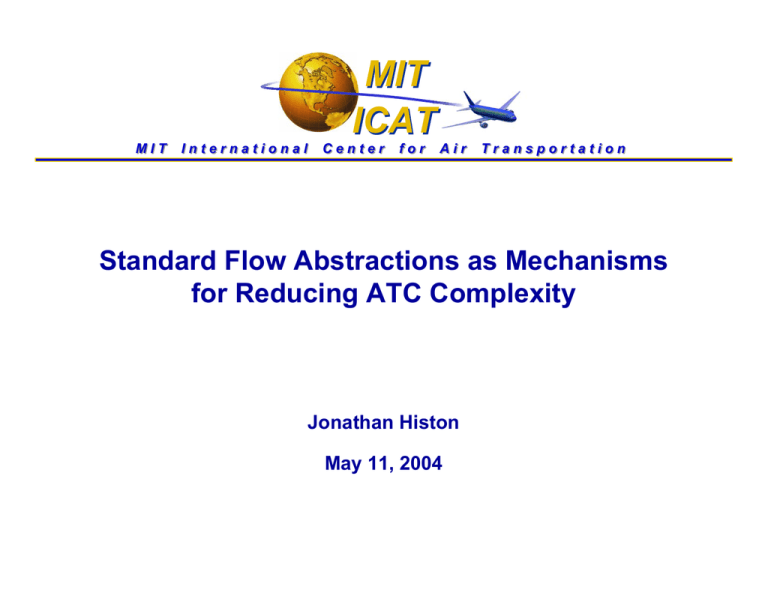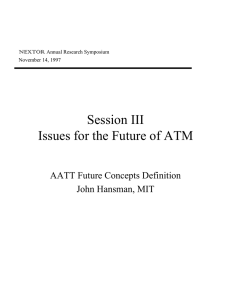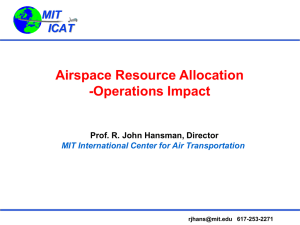MIT ICAT Standard Flow Abstractions as Mechanisms for Reducing ATC Complexity
advertisement

MIT International MIT ICAT Center for Air Transportation Standard Flow Abstractions as Mechanisms for Reducing ATC Complexity Jonathan Histon May 11, 2004 MIT ICAT Introduction y Research goal: Improve our understanding of complexity in the ATC domain. y Complexity represents a limiting factor in ATC operations: Limit sector and system capacity to prevent controller “overload.” y ATC environment is extremely structured: Standardized procedures Division of airspace into sectors ATC preferred routes y Structure is believed to be an important influence on cognitive complexity. Not considered in current metrics. y Research Question: What is the relationship between this structure and cognitive complexity? Not quite right - I need to iterate on this more.... Picture From FlightExplorer Software 2 MIT ICAT Previous Work: Structure-Based Abstractions y Standard Flows Aircraft classified into standard and nonstandard classes based on relationship to established flow patterns. y Groupings Common, shared property, property can define non-interacting groups of aircraft o E.g. non-interacting flight levels y Critical Points Sector “Hot Spots” Reduce problem from 4D to 1D “time-ofarrival”. Standard flow Non-standard aircraft Grouping Critical point Standard flow Standard aircraft Sector boundary 3 MIT ICAT Example Basis for Standard Flow Abstraction > 0.5 Density Map, Utica Sector (ZBW), October 19, 2001 4 MIT ICAT Mechanisms of Structure y Hypothesis: structure-based abstractions reduce cognitive / situation complexity through reducing “order” of problem space y Where “order” is a measure of the dimensionality of the problem y Example: 1 D Problem Space (T) 2 D Problem Space ( X, T ) “Point” Scenario “Line” Scenario 3 D Problem Space (X, Y, T ) “Area” Scenario 5 MIT ICAT Experiment Task y Observe ~ 4 minutes of traffic flow through “sector” y Monitor for potential conflicts y When suspect conflict, pause simulation and identify aircraft involved 6 MIT ICAT Experiment Design y Independent Variable 3 Levels of “problem dimensionality” o “Area” o “Line” o “Point” y Dependent Variables Time-to-Conflict when detected Detection accuracy Subjective questionnaires y Within Subjects design Conflict: Point Line Area C1 C2 C3 C4 C5 C6 6 conflicts (trials) per level of independent variable Scenario for each level of independent variable o All conflicts for each level occurred within the scenario Order of scenarios counterbalanced 7 MIT ICAT Equivalency of Levels of Independent Variable y In order to evaluate hypothesis, scenarios should be as similar as possible y Scenario design established general similarity: Same aircraft rate (~ 6.5 aircraft / minute / flow) Same range of # of aircraft on screen (6-12 aircraft) Similar range of # of aircraft on screen when conflict occurred o Point: 9 +/- 1 o Area: 9 +/- 2 o Line: 9 +/- 2 8 MIT ICAT 19 Participants y Predominantly students 2 Air Traffic Control Trainees from France y Predominantly male (80%) y Age ranged from 23 – 42 y Few participants regularly play computer games (27%) Most never played ATC simulations (71%) 9 MIT ICAT Both Aircraft Visible Primary Dependent Variable: Time-to-Conflict User Identifies Conflict Time-toConflict Conflict Occurs Time 10 MIT ICAT y y Computed average Time-toconflict per scenario for each subject ANOVA is significant at p < 0.00002 Follow-up two-tailed ttests indicate all differences statistically significant at p < 0.002 10.0 T im e -to -C o n flic t (s e c ) y Conflicts are Identified Earlier in “Point” and “Line” Scenarios 8.0 6.0 4.0 2.0 0.0 Point Line Area 11 MIT ICAT Time-to-Conflict Distributions y Peak in “Line” condition clearly earlier than for “Area” y “Point” condition much flatter Sharp drop indicative of attention capture? 25% Point Line Area 15% 10% 5% % of Conflicts 20% 0% 10.0 8.0 6.0 4.0 Time-to-Conflict (sec) 2.0 Missed 12 More Errors Occurred in “Area” Scenario MIT ICAT Missed detections occurred primarily in the “Area” Scenario y Incorrect identifications occurred primarily in the “Area” Scenario 15% 2.50 Incorrect Conflicts (per Scenario) % of Conflicts Missed y 10% 5% 0% Point Line Area 2.00 1.50 1.00 0.50 0.00 Point Line Area 13 MIT ICAT Subjects are Least Comfortable Identifying Conflicts in “Area” Scenario Did you feel you were able to comfortably identify all conflicts in the scenario? Average Comfort Level “Very Comfortable” “Not Very Comfortable” 5.0 4.0 3.0 2.0 1.0 Point Line Area 14 MIT ICAT Most Subjects Identified Point Scenario as Easiest Which scenario did you find it easiest to identify conflicts in? % of Subjects 67% 33% 0% Point Line Area All Same 15 MIT ICAT Subject Comments y “Think aloud” protocol Pair-wise comparisons Grouping / Standard flow indicators o “gap”, “between them”, “through here” y What made the hardest scenario difficult? “Lack of predetermined routes … Lack of intersection points between possible routes” “Multiple horizontal streams - gives multiple intersection venues. Hard to memorize them and monitor them continuously” y What made the easiest scenario easier? “The intersecting stream structure made it simpler to do. …Simultaneous near collisions were not possible, so I could pay more attention to the aircraft with near-term possible conflicts.” 16 MIT ICAT Two Issues Probed Further y Possible Learning Effect Due to Design of Training y Characteristics of Individual Conflicts 17 MIT ICAT Training Issue y Previous results encompass entire population of subjects y Initial group of 6 showed some possible learning effects: 80% 60% 40% 20% 0% First Middle Last All Same Position of Easiest Scenario Average Comfort Level % of Responses Easiest scenario usually identified as “last” scenario Average comfort level slightly higher in last scenario User comments strongly suggesting easiest scenario was easier because of experience 5.0 4.0 3.0 2.0 1.0 First Middle Last Scenario Position 18 MIT ICAT Modifications to Training y Created new training scenarios: Subjects trained on 14 conflicts (increase from 4) Subjects completed 2 complete practice scenarios (increase from 0) Exposed to subjects to all conditions (vs. only point condition) % of Responses 80% Training 1 Training 2 60% 40% 20% 0% First Middle Last All Same Position of Easiest Scenario Average Comfort Level y New training appears to have changed perceived training effect: 5.0 Training 1 Training 2 4.0 3.0 2.0 1.0 First Middle Last Scenario Position 19 MIT ICAT Little change on Time-toConflict performance: 10.0 Training 1 y Training 2 8.0 6.0 4.0 2.0 0.0 First M iddle Last Time-to-Conflict (sec) Time-to-Conflict (sec) y Effect on Performance Exposure to Line and Area in training appears to have decreased performance 10.0 Training 1 Training 2 8.0 6.0 4.0 2.0 0.0 Point Line Area 20 MIT ICAT Characteristics of Conflicts: Conflict Exposure Time Time-to-Conflict Time Both Aircraft Visible User Identifies Conflict Conflict Occurs “Conflict Exposure” 21 MIT ICAT Conflict Exposure Times C1 C2 C3 C4 C5 C6 C1 C2 C3 C4 C5 C6 C1 C2 C3 C4 C5 C6 POINT LINE AREA 0.0 10.0 20.0 30.0 Conflict Exposure Time (sec) 40.0 22 MIT ICAT Comparison of “Quick” Conflicts ( < 7 sec) Time-to-Conflict (sec) 6.0 5.0 4.0 3.0 2.0 1.0 0.0 Line Area 23 MIT ICAT C1 C2 C3 C4 C5 C6 C1 C2 C3 C4 C5 C6 C1 C2 C3 C4 C5 C6 Differences Between “Quick” Line and “Area” Reflected in Error Data 5% 0% 5% POINT 5% 0% 0% 0% 0% LINE 5% 5% 11% 0% 11% 21% AREA 5% 26% 0% 0% 5% 10% 20% % of Conflicts Missed 30% 40% 24 MIT ICAT Selected only those conflicts with Conflict Exposure Times of 20 +/- 5 sec C1 C2 C3 C4 C5 C6 C1 C2 C3 C4 C5 C6 C1 C2 C3 C4 C5 C6 POINT LINE AREA 0.0 10.0 20.0 30.0 Conflict Exposure Time (sec) 40.0 y Time-to-Conflict (sec) y Variance of Conflict Exposure Time Does Not Change Fundamental Result ANOVA still significant at p < 0.005 10.0 8.0 6.0 4.0 2.0 0.0 Point Line Area 25 MIT ICAT Challenges and Insights y Display design issues: Overlapping data tags Effect of choice of separation standard y Experiment design issues: Importance of pilot testing through statistical analysis Scenario design is difficult! y Establishing “equivalency” of scenarios provides insight into characterizing complexity Categorizing aircraft based on point of closest approach 26 MIT ICAT Summary y Results support hypothesis that problem spaces of fewer dimensions reduce complexity Performance Subjective assessments User comments y Identified and addressed potential learning effect 27 MIT International MIT ICAT Center for Air Transportation Backup Slides MIT ICAT 15 Participants % of Subjects % of Subjects 100% 80% 60% 40% 20% 100% 75% 50% 25% 0% Yes 0% Male Have You Ever Played any ATC Simulation Games? Female % of Subjects % of Subjects Gender 45% 30% 15% 0% <25 25 29 Age 30 34 35 39 40 44 No 80% 60% 40% 20% 0% Never From M onthly At Least Several Once a Times a Time-toWeek Week Time Daily How Often Do You Play Computer Games? 29 # of Subjects MIT ICAT ATC Experience? 10 8 6 4 2 0 None Slight Fairly Very Familiar Controller How Familiar with ATC Concepts and Typical Operating Procedures Are You? 30 Differences Clearer in Cumulative Distributions MIT ICAT y How many conflicts were identified by “at least” this much time prior to the conflict? 75% 50% 25% % of Conflicts 100% Point Line Area 0% 10.0 8.0 6.0 4.0 2.0 Missed Time-to-Conflict (sec) 31 In Line, Quick Conflict is Unremarkable MIT ICAT 100% 90% 80% Quick Conflict 60% 50% 40% 30% % of Conflicts 70% Line Line Line Line Line Line - C1 - C2 - C3 - C4 - C5 - C6 20% Shorter Conflict 10% 0% 10.0 8.0 6.0 4.0 Tim e-to-Conflict (sec) 2.0 M issed 32 “Point” Conflicts Very Consistent MIT ICAT (No “Quick” / “Long” Possible) 100% 90% 70% 60% 50% 40% 30% % of Conflicts 80% Point - C1 Point - C2 Point - C3 Point - C4 Point - C5 Point - C6 20% 10% 0% 9.0 6.0 3.0 T im e-to-Conflict (sec) Missed 33 MIT ICAT In “Area”, Both Quick and Long Conflicts Were Among Worst Performance 100% 90% 70% 60% Long Conflict Quick Conflict 10.0 8.0 6.0 4.0 T im e-to-Conflict (sec) 2.0 50% 40% 30% % of Conflicts 80% Area Area Area Area Area Area - C1 - C2 - C3 - C4 - C5 - C6 20% 10% 0% Missed 34 Total Time Spent Paused (sec) MIT ICAT Total Time “Paused” Indicates Less Confidence in Selections in “Area” Scenario Not Statistically Significant at p < 0.10 1:30 1:15 1:00 0:45 0:30 0:15 0:00 Point Line Area 35 Time-to-Conflict Data was Inconclusive Time-to-Conflict (sec) MIT ICAT 10.0 8.0 6.0 4.0 2.0 0.0 First Middle Last Scenario Position 36



